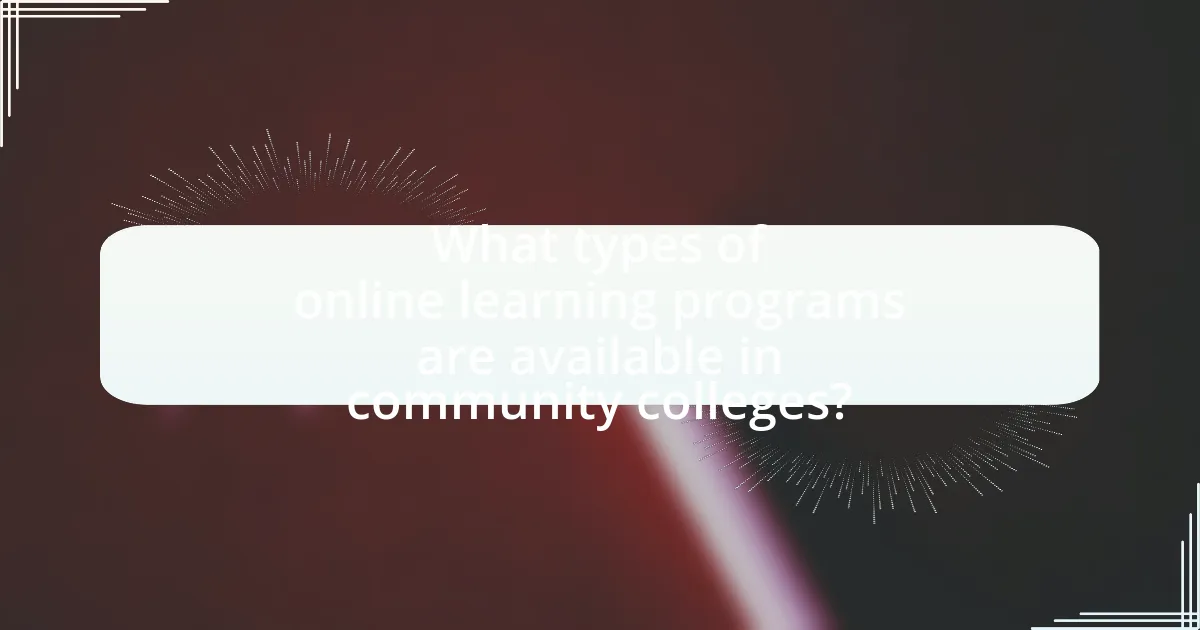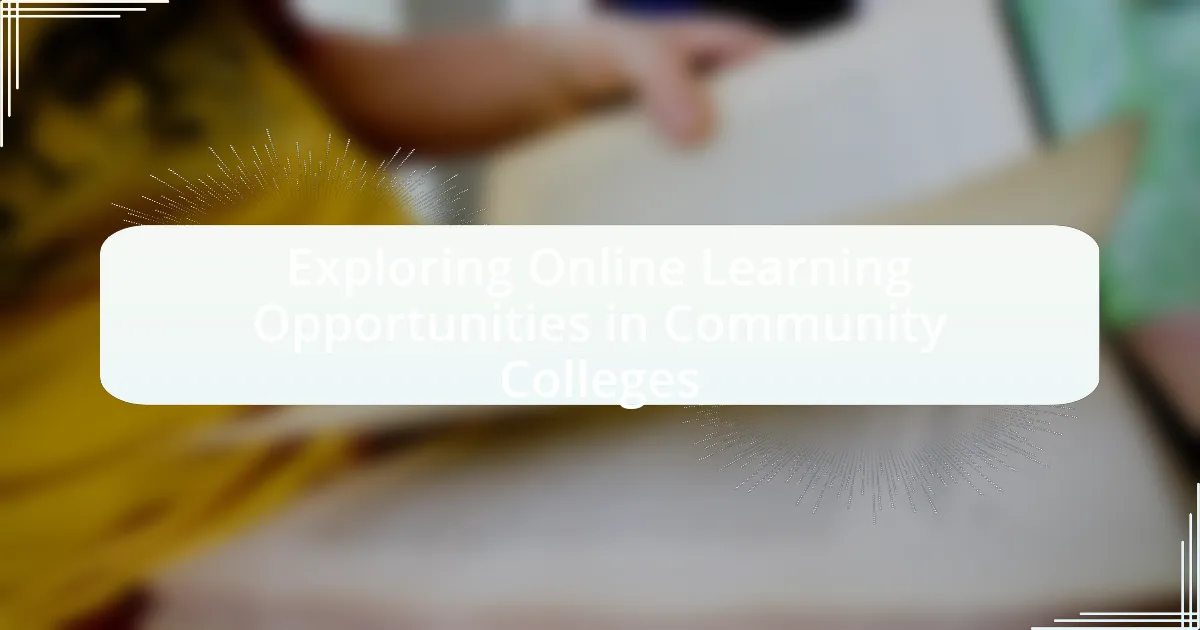The article focuses on online learning opportunities in community colleges, highlighting the variety of courses and programs available for remote completion. It discusses the differences between online and traditional learning, emphasizing the flexibility and accessibility of online education, which caters to diverse student populations, including working adults and those with family commitments. Key features of online learning, such as accommodating different learning styles and offering various course formats, are examined, along with the importance of these opportunities in increasing access to education and aligning with workforce needs. Additionally, the article addresses challenges faced by online learners and provides strategies for effective engagement and success in an online learning environment.

What are Online Learning Opportunities in Community Colleges?
Online learning opportunities in community colleges include a variety of courses and programs that can be completed remotely, allowing students to access education from anywhere. These opportunities often encompass degree programs, certificate courses, and non-credit classes across diverse fields such as business, healthcare, technology, and the arts. According to the American Association of Community Colleges, over 70% of community colleges offer online courses, reflecting a significant trend towards digital education. This accessibility enables students to balance their studies with work and personal commitments, making higher education more attainable.
How do online learning opportunities differ from traditional learning?
Online learning opportunities differ from traditional learning primarily in their delivery method and accessibility. Online learning utilizes digital platforms to provide education, allowing students to access materials and participate in courses from anywhere with an internet connection, while traditional learning typically occurs in physical classrooms with scheduled in-person attendance. According to a report by the National Center for Education Statistics, as of 2020, about 35% of postsecondary students were enrolled in at least one distance education course, highlighting the growing trend and acceptance of online learning as a viable alternative to traditional methods.
What are the key features of online learning in community colleges?
The key features of online learning in community colleges include flexibility, accessibility, diverse course offerings, and interactive learning environments. Flexibility allows students to learn at their own pace and schedule, accommodating various personal and professional commitments. Accessibility ensures that students can participate from anywhere, often with lower costs compared to traditional in-person classes. Community colleges typically offer a wide range of courses online, catering to different interests and career paths. Interactive learning environments, facilitated by technology, promote engagement through discussion forums, multimedia resources, and virtual collaboration tools. These features collectively enhance the educational experience for a diverse student population.
How do online courses accommodate different learning styles?
Online courses accommodate different learning styles by offering diverse instructional methods and materials tailored to individual preferences. For instance, visual learners benefit from videos and infographics, while auditory learners engage with podcasts and recorded lectures. Kinesthetic learners can participate in interactive simulations and hands-on projects. Research indicates that incorporating multiple modalities enhances retention and understanding, as supported by studies like those conducted by Fleming and Mills, which highlight the effectiveness of multimodal learning approaches. This adaptability in online courses ensures that various learning styles are effectively addressed, promoting a more inclusive educational environment.
Why are online learning opportunities important for community colleges?
Online learning opportunities are important for community colleges because they enhance accessibility and flexibility for diverse student populations. Community colleges serve a wide range of learners, including working adults and those with family commitments, and online courses allow these individuals to pursue education without the constraints of traditional classroom schedules. According to the National Center for Education Statistics, over 30% of community college students are enrolled in at least one online course, indicating a significant demand for such offerings. Additionally, online learning can help community colleges expand their reach beyond geographical limitations, attracting students from various locations and increasing enrollment.
What role do online programs play in increasing access to education?
Online programs significantly enhance access to education by removing geographical barriers and providing flexible learning options. These programs allow students from diverse backgrounds, including those in remote areas or with work and family commitments, to pursue higher education without the constraints of traditional classroom settings. According to a report by the National Center for Education Statistics, enrollment in online courses has increased by over 300% in the last decade, indicating a growing reliance on this mode of education to meet the needs of a broader student population.
How do online learning opportunities support diverse student populations?
Online learning opportunities support diverse student populations by providing flexible access to education that accommodates various learning styles, schedules, and backgrounds. This flexibility allows students from different demographics, including working adults, parents, and those with disabilities, to engage in learning at their own pace and convenience. Research indicates that online courses can increase enrollment and retention rates among underrepresented groups, as they often face barriers to traditional classroom settings. For instance, a study by the Community College Research Center found that online learning can enhance access for low-income students, enabling them to balance education with work and family responsibilities.

What types of online learning programs are available in community colleges?
Community colleges offer various types of online learning programs, including degree programs, certificate programs, and non-credit courses. Degree programs typically encompass associate degrees in fields such as business, healthcare, and information technology, allowing students to earn a recognized qualification entirely online. Certificate programs focus on specific skills or knowledge areas, often designed for workforce development or career advancement. Non-credit courses provide opportunities for personal enrichment or professional development, covering topics like computer skills, languages, and arts. According to the American Association of Community Colleges, over 70% of community colleges in the U.S. provide online courses, reflecting the growing demand for flexible learning options.
What are the different formats of online courses offered?
The different formats of online courses offered include asynchronous courses, synchronous courses, hybrid courses, and self-paced courses. Asynchronous courses allow students to access materials and complete assignments on their own schedule, while synchronous courses require real-time participation in lectures and discussions. Hybrid courses combine both online and in-person elements, providing flexibility and interaction. Self-paced courses enable learners to progress through the material at their own speed, accommodating various learning styles and schedules. These formats cater to diverse student needs and preferences in community colleges, enhancing accessibility and engagement in online learning.
How do synchronous and asynchronous courses compare?
Synchronous courses require students to attend classes at scheduled times, promoting real-time interaction, while asynchronous courses allow students to access materials and complete assignments at their own pace. This fundamental difference affects student engagement and flexibility; synchronous courses foster immediate feedback and collaboration, whereas asynchronous courses offer greater convenience and accessibility. Research indicates that 70% of students prefer the flexibility of asynchronous learning, highlighting its appeal in community college settings where diverse schedules exist.
What are hybrid courses and how do they function?
Hybrid courses are educational programs that combine traditional face-to-face classroom instruction with online learning components. These courses function by allowing students to attend some classes in person while completing other coursework online, providing flexibility and accessibility. Research indicates that hybrid courses can enhance student engagement and learning outcomes, as they cater to diverse learning styles and schedules. For instance, a study published in the “Journal of Educational Technology & Society” found that students in hybrid courses reported higher satisfaction and better performance compared to those in fully online or fully in-person courses.
What degree and certificate programs can be pursued online?
Online degree and certificate programs include associate degrees, bachelor’s degrees, master’s degrees, and various professional certificates across fields such as business, healthcare, information technology, education, and liberal arts. Community colleges often offer these programs to provide flexible learning options for students. For instance, the National Center for Education Statistics reported that as of 2020, over 60% of public two-year institutions offered online courses, reflecting the growing trend in online education.
Which fields of study are most commonly offered online?
The fields of study most commonly offered online include business administration, information technology, healthcare, education, and liberal arts. According to the National Center for Education Statistics, business programs consistently rank as the most popular online degree offerings, followed closely by IT and healthcare-related fields, reflecting the growing demand for skills in these areas. Additionally, the flexibility of online education makes it an attractive option for students pursuing degrees in education and liberal arts, further contributing to their prevalence in online learning platforms.
How do online programs align with workforce needs?
Online programs align with workforce needs by offering flexible, relevant training that matches the skills demanded by employers. These programs are designed in collaboration with industry partners to ensure that the curriculum reflects current job market requirements. For instance, a report from the Georgetown University Center on Education and the Workforce indicates that 65% of jobs will require postsecondary education by 2020, highlighting the necessity for educational institutions to adapt their offerings to meet these evolving demands. Additionally, online programs often incorporate real-world projects and internships, further bridging the gap between education and employment.

How can students effectively engage with online learning opportunities?
Students can effectively engage with online learning opportunities by actively participating in discussions, completing assignments on time, and utilizing available resources. Active participation enhances understanding and retention of material, as studies show that students who engage in discussions perform better academically. Completing assignments punctually fosters discipline and reinforces learning, while utilizing resources such as online libraries and tutoring services provides additional support, leading to improved outcomes. Research indicates that students who engage with their learning environment are more likely to succeed, highlighting the importance of these strategies in online education.
What strategies can enhance the online learning experience?
Effective strategies to enhance the online learning experience include fostering active engagement, utilizing diverse multimedia resources, and implementing regular feedback mechanisms. Active engagement can be achieved through interactive discussions, group projects, and real-time quizzes, which have been shown to improve retention rates by up to 60% (Freeman et al., 2014). Diverse multimedia resources, such as videos, podcasts, and infographics, cater to different learning styles and can increase understanding and retention, as supported by research indicating that multimedia learning can enhance comprehension by 50% (Mayer, 2009). Regular feedback mechanisms, including formative assessments and peer reviews, help learners identify areas for improvement and have been linked to higher academic performance, with studies showing that timely feedback can boost student achievement by 30% (Hattie & Timperley, 2007).
How can students stay motivated in an online learning environment?
Students can stay motivated in an online learning environment by setting clear goals and maintaining a structured schedule. Establishing specific, measurable objectives helps students focus their efforts and track progress, which is crucial for motivation. Research indicates that students who set goals are more likely to achieve higher academic performance, as they have a clear direction and purpose (Locke & Latham, 2002). Additionally, creating a consistent routine fosters discipline and reduces procrastination, further enhancing motivation. Engaging with peers through discussion forums or study groups can also provide social support, which is essential for maintaining enthusiasm and accountability in an online setting.
What resources are available to support online learners?
Online learners have access to various resources, including academic support services, online libraries, tutoring programs, and community forums. Academic support services often provide access to advisors who can assist with course selection and academic planning. Online libraries offer a wealth of digital resources, including e-books, journals, and databases, which are essential for research and study. Tutoring programs connect learners with peers or instructors for additional help in specific subjects, enhancing understanding and performance. Community forums facilitate interaction among students, allowing them to share experiences, ask questions, and collaborate on projects, fostering a sense of belonging and support in the online learning environment.
What challenges do students face in online learning?
Students face several challenges in online learning, including lack of motivation, technical difficulties, and limited interaction with instructors and peers. These challenges can hinder their academic performance and overall learning experience. For instance, a study by the Online Learning Consortium found that 70% of online students reported feeling isolated, which negatively impacts their engagement and motivation. Additionally, technical issues such as unreliable internet access can disrupt learning, with 15% of students in community colleges citing this as a significant barrier. Furthermore, the absence of face-to-face interaction can lead to misunderstandings and a lack of support, making it difficult for students to seek help when needed.
How can students overcome technical difficulties in online courses?
Students can overcome technical difficulties in online courses by utilizing available resources such as technical support services, online tutorials, and peer assistance. Accessing technical support services provided by the educational institution can help students troubleshoot issues effectively, as many community colleges offer dedicated help desks or IT support specifically for online learners. Additionally, online tutorials can provide step-by-step guidance on using various platforms and tools, which is crucial for navigating course materials. Engaging with peers through discussion forums or study groups can also facilitate problem-solving, as students can share their experiences and solutions to common technical challenges. These strategies are supported by research indicating that peer collaboration and institutional support significantly enhance online learning experiences.
What are common pitfalls in online learning and how can they be avoided?
Common pitfalls in online learning include lack of engagement, poor time management, and inadequate technical skills. To avoid these issues, students should actively participate in discussions and group work to enhance engagement, create a structured schedule to manage their time effectively, and seek training or resources to improve their technical skills. Research indicates that students who engage with peers and instructors are more likely to succeed, as highlighted in a study by the Online Learning Consortium, which found that interactive learning environments significantly boost retention rates.
What best practices should students follow for successful online learning?
Students should establish a structured routine for successful online learning. This includes setting specific study times, creating a dedicated study space, and adhering to a consistent schedule to enhance focus and productivity. Research indicates that students who maintain a regular study routine are more likely to achieve higher academic performance, as it fosters discipline and time management skills. Additionally, engaging actively with course materials, participating in discussions, and seeking help when needed further contribute to effective online learning outcomes.
How can time management improve online learning outcomes?
Time management can significantly improve online learning outcomes by enhancing students’ ability to organize their study schedules and prioritize tasks effectively. When students allocate specific time slots for learning activities, they are more likely to engage consistently with course materials, leading to better retention of information and higher academic performance. Research indicates that students who practice effective time management strategies report increased motivation and reduced stress levels, which are crucial for successful online learning. For instance, a study published in the “Journal of Educational Psychology” found that students who utilized time management techniques achieved higher grades compared to those who did not, demonstrating a clear link between time management and improved learning outcomes.
What role does communication play in online courses?
Communication is essential in online courses as it facilitates interaction between instructors and students, enhancing the learning experience. Effective communication helps clarify course content, fosters engagement, and builds a sense of community among participants. Research indicates that students in online courses with high levels of interaction and communication perform better academically. For instance, a study by Moore and Kearsley (2012) highlights that effective communication strategies significantly improve student satisfaction and retention rates in online learning environments.

Leave a Reply